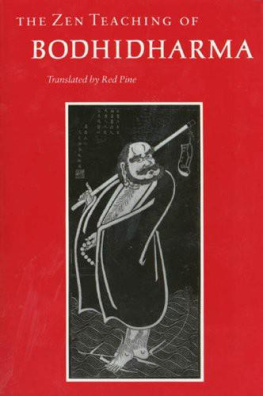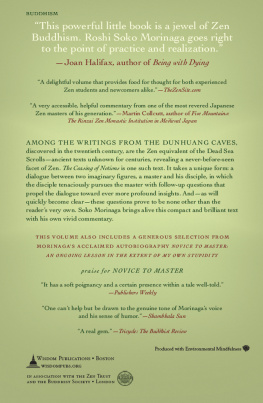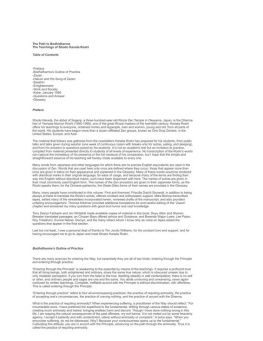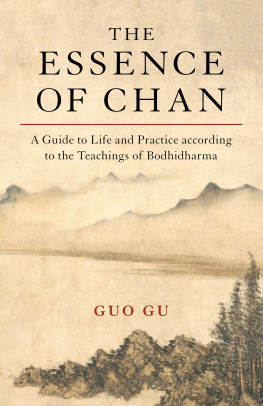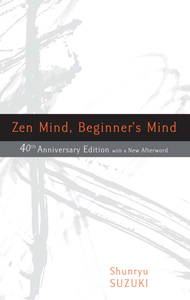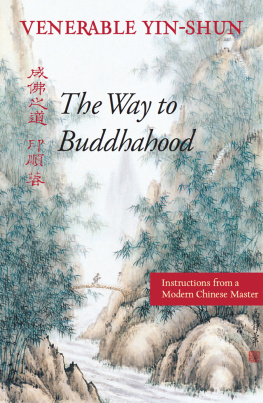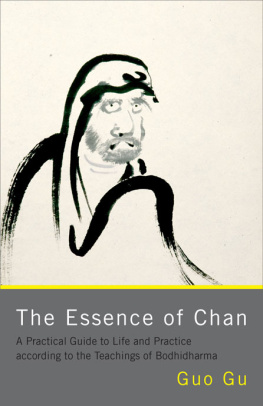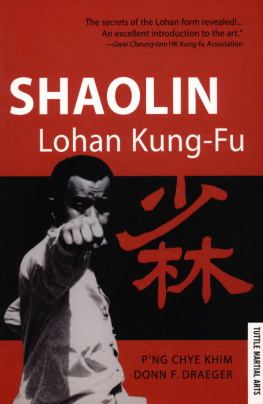
for John Blofeld
Table of Contents
Buddhism came to China 2,000 years ago. As early as A.D. 65, a community of Buddhist monks was reported living under royal patronage in the northern part of Kiangsu Province, not far from the birthplace of Confucius, and the first monks had probably arrived a hundred years earlier. Since then, tens of thousands of Indian and Central Asian monks have journeyed to China by land and sea, but among those who brought the teachings of the Buddha to China, none has had an impact comparable to that of Bodhidharma.
Unknown to all but a few disciples during his lifetime, Bodhidharma is the patriarch of millions of Zen Buddhists and students of kung-fu. He is the subject of many legends as well. Along with zen and kung-fu, Bodhidharma reportedly also brought tea to China. To keep from falling asleep while meditating, he cut off his eyelids, and where they fell, tea bushes grew. Since then, tea has become the beverage of not only monks but everyone in the Orient. Faithful to this tradition, artists invariably depict Bodhidharma with bulging, lidless eyes.
As often happens with legends, its become impossible to separate fact from fiction. His dates are uncertain; in fact, I know at least one Buddhist scholar who doubts that Bodhidharma ever existed. But at the risk of writing about a man who never lived, Ive sketched a likely biography, based on the earliest records and a few of my own surmises, to provide a backdrop for the sermons attributed to him.
Bodhidharma was born around the year 440 in Kanchi, the capital of the Southern Indian kingdom of Pallava. He was a Brahman by birth and the third son of King Simhavarman. When he was young, he was converted to Buddhism, and later he received instruction in the Dharma from Prajnatara, whom his father had invited from the ancient Buddhist heartland of Magadha. It was Prajnatara who also told Bodhidharma to go to China. Since the traditional overland route was blocked by the Huns, and since Pallava had commercial ties throughout Southeast Asia, Bodhidharma left by ship from the nearby port of Mahaballipuram. After skirting the Indian coast and the Malay Peninsula for three years, he finally arrived in Southern China around 475.
At that time the country was divided into the Northern Wei and Liu Sung dynasties. This division of China into a series of northern and southern dynasties had begun in the early third century and continued until the country was reunited under the Sui dynasty in the late sixth century. It was during this period of division and strife that Indian Buddhism developed into Chinese Buddhism, with the more military-minded northerners emphasizing meditation and magic and the more intellectual southerners preferring philosophical discussion and the intuitive grasp of principles.
When Bodhidharma arrived in China, in the latter part of the fifth century, there were approximately 2,000 Buddhist temples and 36,000 clergy in the South. In the North, a census in 477 counted 6,500 temples and nearly 80,000 clergy. Less than fifty years later, another census conducted in the North raised these figures to 30,000 temples and 2,000,000 clergy, or about 5 percent of the population. This undoubtedly included many people who were trying to avoid taxes and conscription or who sought the protection of the Church for other, nonreligious, reasons, but clearly Buddhism was spreading among the common people north of the Yangtze. In the South, it remained largely confined to the educated elite until well into the sixth century.

Following his arrival in the port of Nanhai, Bodhidharma probably visited Buddhist centers in the South and began learning Chinese, if he hadnt done so already on his way from India. According to Tao-yuans Transmission of the Lamp , finished in 1002, Bodhidharma arrived in the South as late as 520 and was invited to the capital in Chienkang for an audience with Emperor Wu of the Liang dynasty, successor to the Liu Sung. During this meeting the emperor asked about the merit of performing religious works, and Bodhidharma responded with the doctrine of emptiness. The emperor didnt understand, and Bodhidharma left. The earliest records, however, mention no such meeting.
In any case, Bodhidharma crossed the Yangtzeaccording to legend, on a hollow reedand settled in the North. At first he stayed near the Northern Wei capital of Pingcheng. In 494, when Emperor Hsiao-wen moved his capital south to Loyang on the northern bank of the Lo River, most of the monks living in the Pingcheng area moved too, and Bodhidharma was probably among them. According to Tao-hsuans Further Lives of Exemplary Monks , the first draft of which was written in 645, Bodhidharma ordained a monk by the name of Sheng-fu. When the capital was moved to Loyang, Sheng-fu moved to the South. Since ordination normally requires a three-year apprenticeship, Bodhidharma must have already been in the North by 490 and must have been reasonably conversant in Chinese by then.
A few years later, in 496, the emperor ordered the construction of Shaolin Temple on Mount Sung, in Honan Province southeast of Loyang. The temple, which still exists (although largely as a tourist attraction), was built for another meditation master from India, not for Bodhidharma. But while zen masters have come and gone at the temple for the past 1,500 years, Bodhidharma is the only monk anyone but a Buddhist historian associates with Shaolin. It was here, on Mount Sungs western Shaoshih Peak, that Bodhidharma is said to have spent nine years in meditation, facing the rock wall of a cave about a mile from the temple. Shaolin later became famous for training monks in kung-fu, and Bodhidharma is honored as the founder of this art as well. Coming from India, he undoubtedly instructed his disciples in some form of yoga, but no early records mention him teaching any exercise or martial art.
By the year 500, Loyang was one of the largest cities in the world, with a population of over half a million. When Emperor Hsuan-wu died in 516 and the Empress Dowager Ling assumed control of the government, one of her first acts was to order the construction of Yung-ning Temple. The construction of this temple and its 400-foot-high pagoda nearly exhausted the imperial treasury. According to a record of Loyangs temples written in 547 by Yang Hsuan-chih, the golden wind-chimes that hung along the temples eaves could be heard for three miles and the spire of the temples pagoda could be seen over thirty miles away. Yangs account includes the comments of a monk from the West named Bodhidharma, who called it the most imposing structure he had ever seen. Since the temple wasnt built until 516 and was destroyed by fire in 534, Bodhidharma must have been in the capital around 520. Early records say he traveled throughout the Loyang area, coming and going with the seasons. In the capital, though, he must have stayed at Yung-ming Temple. Not to be confused with Yung-ning Temple, Yung-ming had been built a few years earlier, at the beginning of the sixth century, by Emperor Hsuan-wu as a headquarters for foreign monks. Before the mass evacuation of the city during the collapse of the Northern Wei in 534, the temple reportedly housed over 3,000 monks from countries as far away as Syria.
Despite the sudden popularity of Buddhism in China, Bodhidharma found few disciples. Besides Sheng-fu, who moved to the South soon after his ordination, the only other disciples mentioned are Tao-yu and Hui-ko, both of whom are said to have studied with Bodhidharma for five to six years. Tao-yu, were told, understood the Way but never taught. It was to Hui-ko that Bodhidharma entrusted the robe and bowl of his lineage and, according to Tao-hsuan, a copy of Gunabhadras translation of the Lankavatara Sutra . In the sermons translated here, though, Bodhidharma quotes mostly from the Nirvana, Avatamsaka , and Vimilakirti sutras and uses none of the terminology characteristic of the Lankavatara. Perhaps it was Huik o, not Bodhidharma, who thought so highly of this sutra.
Next page
